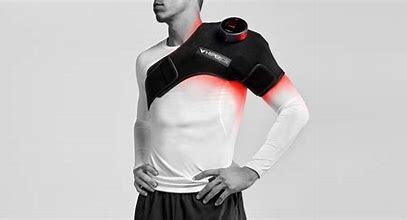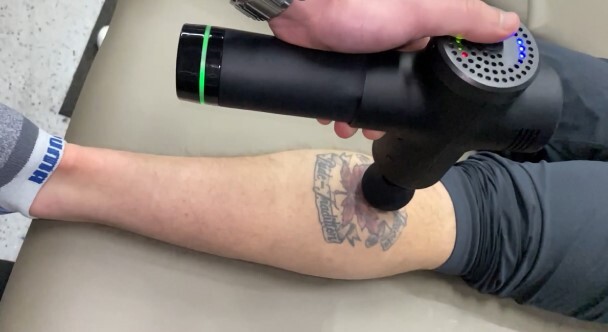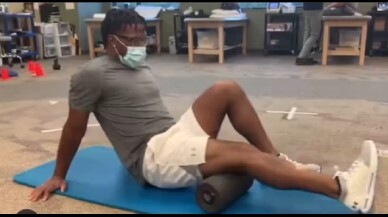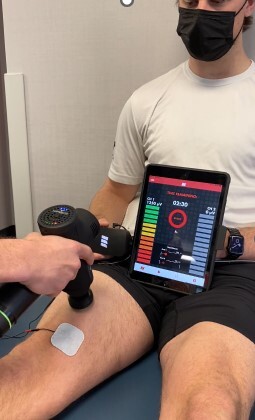Scientific Foundation
Vibration therapy has been around for many years, and recently has regained popularity. Vibration is detected in the skin, muscles and joints by Pacinian corpuscles and travels to the Primary Somatosensory Cortex for processing via the dorsal column ascending neural pathway.1
Application Principles
It has been reported that vibration can alter stretch reflex sensitivity and in turn affect the motor unit threshold, firing rate and maximal voluntary strength on muscle action. It is believed that the effect of vibration largely depends on the duration and frequency of the stimulus provided. If applied briefly (2 – 25 seconds) vibration resulted in additional excitation of the motor neuron pool which increased initial firing rates and ultimately enhanced force production.2,3
However, if applied for prolonged periods (30+ seconds), a decrease in maximal voluntary strength occurs via presynaptic autogenic inhibition.4–6 Presynaptic autogenic inhibition is a reduction of muscle spindle activity and golgi tendon organ activation characterized by lower group Ia mean discharge rates,7 decreased reflex magnitude and increased (slow) reflex latency.8 This ultimately reduces the net excitation of the motor neuron pool and decreases maximal voluntary strength.
Regarding specific application of devices, it is suggested that you work with gentle pressure over the indicated treatment area for 20 to 60 seconds. An area requiring increased treatment can be identified by experiencing a different tactile or auditory sensation. The device will either “thud” and “bounce” more aggressively over affected tissue or practitioners may even hear a different pitch in volume from the typical vibratory sound.
Indications and Contraindications
Vibration therapy may be indicated for myofascial pain, autogenic muscle inhibition and delayed onset muscle soreness. While there are no direct contraindications for its use clinicians should proceed with caution for the treatment of certain conditions. Some examples are stress fractures / reactions, neuropathy, fibromyalgia epilepsy, pregnancy, recent surgery or joint replacement, metal pins or plates, pacemakers, areas with skin rash or open wounds and in individuals with hypertension or those at risk for clotting.
Clinical Application
The ability to regulate muscle activity up or down via vibration is beneficial for clinical use and it is important that practitioners understand the scientific application to appropriately prescribe its use.
While there are many proposed benefits of vibration therapy the literature most strongly supports its clinical application for pain relief, improving tissue extensibility, increasing strength, and decreasing muscle soreness.
The recommendation for application is to provide gentle pressure with continuous motion into the affected tissue. You will know you found an area requiring increased attention when either the response is more pronounced (‘bouncy’) or louder. This does not mean that more pressure is required, simply sustained gentle pressure.
Pain Modulation
In 2015 Lam et al. performed a prospective randomized double-blind study in individuals following arthroscopic rotator cuff repair. They applied a 80-Hz of vibration 5 minutes per day for 6 months following the operation and found significantly lower visual analog (pain) scale scores at the 6 week follow up compared to those who did not receive vibration.9
The author utilizes the Hyperice venom shoulder (Figure 1) prior to treatment with patients following a rotator cuff repair. This helps to provide superficial heat for tissue extensibility combined with vibration for proposed benefits mentioned to improve range of motion in early and mid-phases of rehabilitation.
Figure 1. Hyperice Venom Shoulder unit providing pulsed or continuous vibration in conjunction with superficial heat to reduce pain and improve tissue mobility.

Additionally, this device can be used in the overhead athlete. It is known that internal rotation significantly decreases immediately following and 24 hours after throwing.10 Thus, the author will use this device to provide cool down following a throwing session to help maintain tissue extensibility and reduce the side effects from activity.
Range of Motion
In 2020 Tilp et al. analyzed dorsiflexion ROM following the use of the hypervolt massage gun (Figure 2). They worked for 2.5 minutes on each gastroc head at 53 Hz while the control group received no intervention and found a 5.4% increase in ROM following treatment.11 The group that received intervention demonstrated no change in max voluntary contraction. This has clinical implication in the athletic setting to improve flexibility without compromising strength.
Figure 2. Hyperice Hypervolt+ being applied to the gastrocs to improve tissue extensibility.

In 2021 Nakamura et al further supported this by having two groups perform 3 sets of 60 second bouts of foam rolling from their achilles to popliteal fossa using the Hyperice Vyper 2.0 (Figure 3). One group left the device off and the other set the frequency to 48 Hz and 1.5 mm amp. What they found was that while both groups increased DF PROM the vibration group demonstrated a significant decrease in shear elastic modulus (which correlates with stiffness) and additionally an increase in motor unit recruitment. Those who used the non-vibrating foam roller demonstrated a decrease in maximal voluntary contraction during concentric plantar flexion activity.12
Figure 3. The Hypervice Vyper 2.0 vibrating foam roller being applied from popliteal fossa to Achilles to improve ROM and increase motor unit recruitment.

Based on the data supporting improved ROM and tissue extensibility without loss of strength the author utilizes both vibrating massage guns and vibrating foam rollers during mid to late-stage rehabilitation to prepare individuals for treatment sessions. There has been a great deal of subjective feedback from patients and athletes indicating the improved comfort of a vibrating foam roller as compared to traditional rollers.
Motor Unit Recruitment
Regarding strength Brunetti et al demonstrated that by applying 100Hz & 20µm amps to the distal quadriceps during isometric contraction in patients who underwent ACL reconstruction, peak torque increased at the 90 and 270 day follow up.13 High frequency and high amplitude parameters will increase stimulus to tissue and thus improve neural drive via increased motor unit recruitment.
This principle can be extremely beneficial during early-stage ACL rehab by combining this approach with the use of external biofeedback. Biofeedback devices can help with additional recruitment by providing visual cueing for quadriceps contraction which we know becomes of increasing cognitive demand following an ACL injury.14 Clinically the author has found that by combining the use of vibration devices with quadriceps contraction motor unit recruitment increases on biofeedback versus contraction without additional vibratory stimulus (Figure 4).
Figure 4. Hyperice Hypervolt+ being applied during quadriceps exercises to improve motor unit recruitment during visual biofeedback from the mTrigger biofeedback device.

Delayed Onset Muscle Soreness
Lastly, vibration devices can alleviate delayed onset muscle soreness. Two similarly designed studies indicate that subjective soreness scores and systemic response are improved if vibration stimulus is applied prior to or post exercise.
In 2007 Bakhtiary et al had 50 participants walk for 30 minutes on a 10° decline. Prior to this one group applied vibration therapy to each quadriceps, hamstring, and calf at 50Hz for 1 minute each. The group that did not receive intervention reported a higher soreness rating following the activity, demonstrated decreased isometric voluntary muscle contraction, and even presented with increased serum creatine kinase enzyme in their blood biomarkers indicating inflammation.15
Broadbent et al followed this up in 2011.16 They had two groups of individuals run on a decline for 40 minutes at 70% VO2 max. One group applied 40Hz, 5 mm amplitude once per day for 3 minutes to their quadriceps, hamstrings, calves, and IT band for 5 days following their run while the other did not. What they found was that those who applied vibration therapy had reduced muscle soreness at 24, 96 and 120 hours following. Additionally, they found changes in blood biomarkers: decreased interleukin 6, decreased histamine, decreased lymphocytes, and increased neutrophils; all of which are markers indicating reduced systemic inflammation.
These studies reveal that whether applied prior to or following exercise intervention vibration therapy can alleviate delayed onset muscle soreness not only from a subjective standpoint but an objective component too. This solidifies the importance of use in the clinical rehab or higher-level athletic setting to ensure that individuals can maintain the ability to adhere to the demands of a vigorous training regime.
Recommendations
When it comes to vibration therapy, the author is an advocate for its use based on the benefits mentioned throughout. To summarize lower frequency, amplitude coupled with longer duration (30+ seconds) helps alleviate pain, improve tissue extensibility, and reduce the potential for delayed onset muscle soreness, which can be beneficial in patients who are post-operative, dealing with chronic pain or just finished performing strenuous eccentric exercises. Higher frequency, amplitude with short duration usage (< 30 seconds) can assist with motor unit recruitment and tissue preparedness which can be beneficial prior to or during exercise activity.
Conclusion
Vibration therapy has been all the buzz in recent years due to the many different devices on the market. These devices can be a great adjunct tool to boost performance in rehab and competition. There are many settings and parameters which can yield a variety of clinical outcomes. It is important that practitioners understand the scientific foundation behind these tools to guide clinical application in professional setting and also educate their patients on appropriate use at home. Overall vibration therapy is a safe, inexpensive, and accessible form of treatment with many benefits. Further studies are warranted to study the effects of different frequency, amplitude and time parameters as they relate to physiologic response of tendon and ligament conditions.
References
- Tactile sensory system: encoding from the periphery to the cortex. Jones Lynette A., Smith Allan M. Mar 19;2014 WIREs Systems Biology and Medicine. 6(3):279–287. doi: 10.1002/wsbm.1267. doi: 10.1002/wsbm.1267. [DOI] [PubMed] [Google Scholar]
- Tonic vibration reflexes elicited during fatigue from maximal voluntary contractions in man. Bongiovanni L G, Hagbarth K E. Apr 1;1990 The Journal of Physiology. 423(1):1–14. doi: 10.1113/jphysiol.1990.sp018007. doi: 10.1113/jphysiol.1990.sp018007. [DOI] [PMC free article] [PubMed] [Google Scholar]
- Grande G., Cafarelli E. Experimental Brain Research. 4. Vol. 150. Springer Science and Business Media LLC; Ia afferent input alters the recruitment thresholds and firing rates of single human motor units; pp. 449–457. [DOI] [PubMed] [Google Scholar]
- The effects of vibration-induced altered stretch reflex sensitivity on maximal motor unit firing properties. Barrera-Curiel Alejandra, Colquhoun Ryan J., Hernandez-Sarabia Jesus A., DeFreitas Jason M. Jun 1;2019 Journal of Neurophysiology. 121(6):2215–2221. doi: 10.1152/jn.00326.2018. doi: 10.1152/jn.00326.2018. [DOI] [PubMed] [Google Scholar]
- Jackson Stephen W., Turner Duncan L. European Journal of Applied Physiology. 4. Vol. 88. Springer Science and Business Media LLC; Prolonged muscle vibration reduces maximal voluntary knee extension performance in both the ipsilateral and the contralateral limb in man; pp. 380–386. [DOI] [PubMed] [Google Scholar]
- Effects of prolonged vibration on motor unit activity and motor performance. Shinohara M. 2005Med Sci Sports Exerc. 37:2120–2125,. doi: 10.1249/01.mss.0000178106.68569.7e. doi: 10.1249/01.mss.0000178106.68569.7e. [DOI] [PubMed] [Google Scholar]
- Muscle spindle activity following muscle tendon vibration in man. Ribot-Ciscar Edith, Rossi-Durand Christiane, Roll Jean-Pierre. Dec;1998 Neuroscience Letters. 258(3):147–150. doi: 10.1016/s0304-3940(98)00732-0. doi: 10.1016/s0304-3940(98)00732-0. [DOI] [PubMed] [Google Scholar]
- The effects of acute and prolonged muscle vibration on the function of the muscle spindle’s reflex arc. Pope Zachary K., DeFreitas Jason M. Oct 2;2015 Somatosensory & Motor Research. 32(4):254–261. doi: 10.3109/08990220.2015.1091770. doi: 10.3109/08990220.2015.1091770. [DOI] [PubMed] [Google Scholar]
- Lam Patrick H., Hansen Kaitlyn, Keighley Geffrey, Hackett Lisa, Murrell George A.C. The American Journal of Sports Medicine. 11. Vol. 43. SAGE Publications; A Randomized, Double-Blinded, Placebo-Controlled Clinical Trial Evaluating the Effectiveness of Daily Vibration After Arthroscopic Rotator Cuff Repair; pp. 2774–2782. [DOI] [PubMed] [Google Scholar]
- Reinold Michael M., Wilk Kevin E., Macrina Leonard C., Sheheane Chris, Dun Shouchen, Fleisig Glenn S., Crenshaw Ken, Andrews James R. The American Journal of Sports Medicine. 3. Vol. 36. SAGE Publications; Changes in shoulder and elbow passive range of motion after pitching in professional baseball players; pp. 523–527. [DOI] [PubMed] [Google Scholar]
- The Acute Effects of a Percussive Massage Treatment with a Hypervolt Device on Plantar Flexor Muscles' Range of Motion and Performance. Konrad A., Glashüttner C., Reiner M.M., Bernsteiner D., Tilp M. Nov 19;2020 J Sports Sci Med. 19(4):690–694. [PMC free article] [PubMed] [Google Scholar]
- Comparison Between Foam Rolling With and Without Vibration on Passive and Active Plantar Flexor Muscle Properties. Nakamura Masatoshi, Sato Shigeru, Kiyono Ryosuke, Yoshida Riku, Yasaka Koki, Yahata Kaoru, Konrad Andreas. Sep 1;2021 Journal of Strength and Conditioning Research. doi: 10.1519/jsc.0000000000004123. doi: 10.1519/jsc.0000000000004123. [DOI] [PMC free article] [PubMed]
- Brunetti O., Filippi G. M., Lorenzini M., Liti A., Panichi R., Roscini M., Pettorossi V. E., Cerulli G. Knee Surgery, Sports Traumatology, Arthroscopy. 11. Vol. 14. Springer Science and Business Media LLC; Improvement of posture stability by vibratory stimulation following anterior cruciate ligament reconstruction; pp. 1180–1187. [DOI] [PubMed] [Google Scholar]
- Grooms Dustin R., Page Stephen J., Nichols-Larsen Deborah S., Chaudhari Ajit M.W., White Susan E., Onate James A. Journal of Orthopaedic & Sports Physical Therapy. 3. Vol. 47. Journal of Orthopaedic & Sports Physical Therapy (JOSPT); Neuroplasticity Associated With Anterior Cruciate Ligament Reconstruction; pp. 180–189. [DOI] [PubMed] [Google Scholar]
- Influence of vibration on delayed onset of muscle soreness following eccentric exercise. Bakhtiary A. H, Safavi-Farokhi Z., Aminian-Far A., Rezasoltani A. Mar 1;2007 British Journal of Sports Medicine. 41(3):145–148. doi: 10.1136/bjsm.2006.031278. doi: 10.1136/bjsm.2006.031278. [DOI] [PMC free article] [PubMed] [Google Scholar]
- Vibration therapy reduces plasma IL6 and muscle soreness after downhill running. Broadbent S., Rousseau J. J., Thorp R. M., Choate S. L., Jackson F. S., Rowlands D. S. 2010British Journal of Sports Medicine. 44(12):888–894. doi: 10.1136/bjsm.2008.052100. doi: 10.1136/bjsm.2008.052100. [DOI] [PubMed] [Google Scholar]


